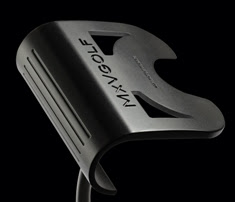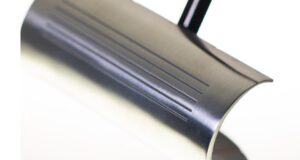The MxV1 putter by MxV Golf features a ball-shaped “Center Strike Technology” face that is designed to provide truer roll and improved accuracy. Creator Brian Wittman is a marketer, designer and entrepreneur with 30 years in the creative and branding business working in the entertainment and technology sectors. He was the original creative director for Priceline.com, responsible for its look and feel and the famed William Shatner commercials. “I took up golf and its related challenges in my mid-40s and have been trying to figure out the game ever since,” he says. On that note, he was inspired to develop a new putter that aims to deliver a perfect strike each time. The MxV1 putter will be released in December. In the meantime, here is our exclusive interview:
Can you please describe the unique face of the MxV1 putter?
The MxV1’s innovative putter face currently takes nearly 10 hours to produce from a solid brass block, finished in a powder coat. It is then custom fitted and assembled. The face is the exact diameter of a golf ball (1.68 inches). It is tubular in shape with regulation grooves designed to deliver a confident, direct strike with no backspin anywhere on its surface. It offers two onboard alignment aids—one on the leading top edge of the face, with markers at the center and stretching the width of a golf ball; and one on the back deck—a cutout the size of a ball that also serves as a lift to scoop the ball off the green. The weight and balance are symmetrical, making it a perfect putter for conventional right and left hand, single bend, straight, long and belly putter shafts.
How does the Center Strike Technology work at impact—and what specific benefits does it deliver?
When used as designed in a steady, level pendulum motion, positioned slightly ahead of the ball, you are essentially hitting a ball with a ball and thereby striking at the ball’s center of gravity, every time. This produces a true roll with zero backspin and a straighter line to the target. Even if miss-struck, slightly off the center, you will still get a straight shot off towards the cup.
Conventional golf wisdom says that putter loft is necessary to lift the ball from its natural depression on the green and get the ball rolling more quickly. What do you say to someone who is concerned about not having loft on their putter?
You could say we intentionally substituted loft for accuracy in the unique design of the MxV1 and have found this to be more consistent in driving the ball to the target. Once you reach the green, most players will mark their ball, if even slightly, off its original natural depression. We’ve tested and retested the MxV1 in and around the “donut,” the eight foot circle outside of the pin that contains “invisible” divots and anomalies. We’ve focused on maintaining a steady, straight, controllable roll with no backspin in the crucial first three feet towards the hole. Because you’re consistently hitting the ball’s center of gravity, with a steady confident swing stride, you gain more accuracy—which is the ultimate goal.
As a side note, we like to promote the click-click sound of Newton’s Cradle in your head, as a tempo, as you aim and engage the putter to the ball.
The putter was initially inspired by the Newton’s Cradle, a popular desk toy. Can you elaborate on that?
When you witness the demonstration of momentum—mass x velocity, hence “mxv”—as shown in the cradle, you’ll see how a ball hitting a ball directly hits the center of gravity each time. This begged the question, why are golf putters flat faced? Clearly, striking an object’s center of gravity with an object of the same shape was more consistent and more easily achieved than striking an object with an opposing shape. There were too many variables otherwise.
We built and tested a “theory model” and proved that the design worked to deliver a more consistent, accurate contact with the ball, moving the ball forward with a true roll, no backspin and therefore a straighter line to the hole. We sent our first prototype to a doctor of physics to substantiate my concept, with remarkable results in his independent testing. We knew then it was time to move this idea forward.
Can you briefly describe the process of going from concept all the way through production and, now, sales? It sounds like a big undertaking?
It’s no doubt exciting taking an idea from concept to the market. Having done it before with many other products of my own and for others, it remains challenging especially when breaking into a new market.
Aesthetically, we’ve married function and style in a way that we’ve not seen before. And, by the looks we’ve gotten on the courses we’ve tested the MxV1, neither has anyone else. One of the biggest hurdles was ensuring that the quality and integrity of the design and the craftsmanship did not suffer in the manufacturing process. We painstakingly worked through “acceptable” models and finishes to achieve “exceptional” ones. This is an upmarket product ($269 suggested retail) for the serious golfer. The MxV1 presently takes nearly 10 hours to build. The end result had better be something worthwhile—not only in its performance but in its overall value and endurance.
Another challenge, of course, is getting the MxV1 into the golfer’s hands. We decided to go viral first, selling directly from our website while at the same time offering selected pro shops a unique consignment package. We’re not exactly a traditional company but we are looking for steady, manageable growth with superior customer satisfaction.
It is a big undertaking, one that is driven by passion and the idea of reinventing the way the game is played. A lofty goal… even without the loft.
 PutterZone – Best Putter Reviews
PutterZone – Best Putter Reviews




